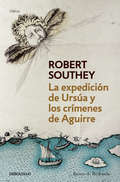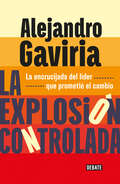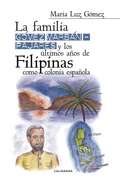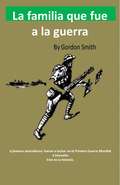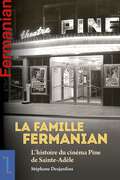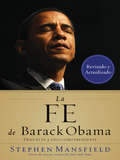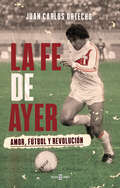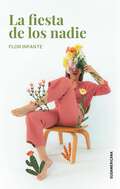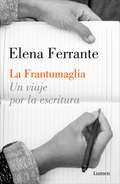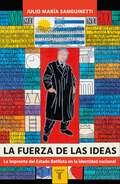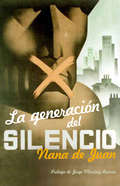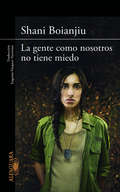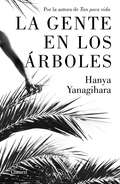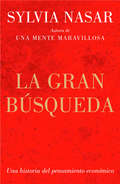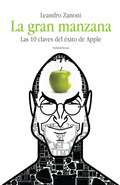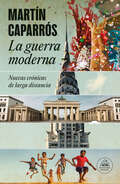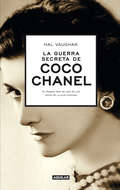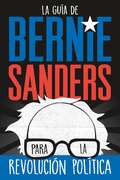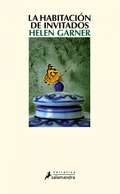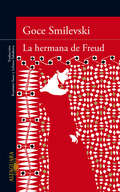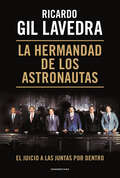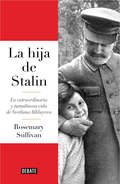- Table View
- List View
La expedición de Ursúa y los crímenes de Aguirre
by Robert SoutheyLos mejores libros jamás escritos. «¿No hemos dado muerte al gobernador del rey? [...] ¿Y vamos a pretender ahora quedar absueltos de toda culpa?» «Pocas figuras del largo arribo hispano a América han generado tanta literatura como Lope de Aguirre, y quizá en ningún caso esta literatura ha revestido tintes tan sombríos.», dice Pere Gimferrer en el prólogo de esta obra. Integrante de la legendaria expedición a El Dorado liderada por Pedro de Ursúa, Aguirre concentra las virtudes y las indignidades del grupo de rudos veteranos que se adentraron en la selva peruana en pos de una quimera inalcanzable. El mal gobierno de Ursúa y un entorno hostil propiciaron la rebelión. Su muerte a manos de la tropa inaugura una violenta lucha de poder liderada por el sanguinario Aguirre, quien acabó con la vida de setenta soldados en noventa días. Con tintes de tragedia shakesperiana, Robert Southey nosasoma al lado más oscuro del corazón humano. La traducción de Soledad Martínez de Pinillos y el prólogo de Pere Gimferrer nos acercan a esta obra maestra del gran hispanista inglés. Reseña:«La peripecia de unos hombres bravos, sin escrúpulos, que nos asoman al fondo oscuro del corazón humano.»Miguel Dalmau, Qué Leer
La explosión controlada: La encrucijada del líder que prometió el cambio
by Alejandro GaviriaEntre las memorias políticas, la crónica y el ensayo, este libro revelador da luces sobre el primer año de gobierno de Gustavo Petro Al cumplirse el primer año del gobierno de Gustavo Petro, Alejandro Gaviria presenta en este ensayo, a modo de memorias políticas, su visión del presidente, así como sus reflexiones sobre los retos y las posibilidades de transformación que había encarnado el candidato de izquierda tras el estallido social de los años recientes. Este testimonio honesto y lúcido no es solo la visión de un economista, de un político escéptico, de un exministro, de un liberal pragmático, es también la esencia del pensamiento de un humanista que entiende que el cambio necesario de la sociedad requiere algo mucho más práctico que la férrea voluntad y la trampa retórica que caracterizan a Petro. "No pretendo hacer predicciones sobre el futuro de Colombia. Tampoco quiero hacer juicios definitivos. Quiero ofrecerles a los lectores una reflexión sobre un país en la encrucijada desde una perspectiva peculiar, privilegiada en un doble sentido: la perspectiva de alguien que estuvo adentro (en el vientre de la ballena, por decirlo de algún modo), que tuvo un conocimiento de primera mano de los asuntos de gobierno, y que al mismo tiempo ha pasado buena parte de su vida inmerso en las ciencias sociales, en la discusión (que nunca termina porque no hay respuestas definitivas) sobre las posibilidades y los obstáculos de la transformación social y cultural de la sociedad colombiana". Tomado de la introducción
La familia Gómez Marbán: Pajares y los últimos años de Filipinas como colonia española
by María Luz GómezHistoria de una familia española en Filipinas durante el último periodo en el que fue colonia de España. <P><P>" El libro trata de mis recuerdos, que juzgo interesantes, sobre la vida de un bisabuelo mío y de su familia. Este fue gobernadormilitar de Filipinas durante la época en que el archipiélago era colonia española. <P>También me ha animado a escribirlo el deseo de dedicar un pequeño homenaje a tanto español que colonizó, defendió, y evangelizó las islas, casi siempre de forma escondida, y a menudo de heroica. <P>Y también a los hijos del archipiélago que, como me contaba mi tía-abuela Isabel, que convivió con ellos muchos años,son en su gran mayoría cariñosos, sonrientes y acogedores y para quienes la familia tiene una importancia capital; son en general excelentes personas, y, en gran número, buenos católicos. <P>Y porque además Filipinas es, si nos referimos a la evangelización católica,nada menos que (en frase de San José María Escrivá, el fundadordel Opus Dei) ¡la vanguardia del Oriente! "
La familia Wittgenstein
by Alexander WaughLa historia de una de las familias más excéntricas, geniales y revolucionarias del siglo XX. «Extraordinario y sorprendente. [...] Encaja a la perfección en la larga lista de obras maestras de no ficción impulsadas por la embriagadora riqueza de la Viena de fin de siglo. [...] Apasionante.»The New York Observer La historia de la familia Wittgenstein es la historia del siglo XX. Karl Wittgenstein fue un industrial millonario vienés, converso y patricio, con especial debilidad por el arte y la alta cultura. Sus ocho hijos nacieron aún bajo el signo del Imperio austrohúngaro, que se extinguiría con la Primera Guerra Mundial. La vida de todos ellos estuvo marcada por el espíritu de la Viena finisecular, aquella que vería crecer a escritores como Robert Musil o Joseph Roth, músicos como Mahler o Richard Strauss, y pintores como Gustav Klimt. Por el palacio de los Wittgenstein desfilaron personalidades de la talla de Brahms o Sigmund Freud. Sin embargo, esa atmósfera de prosperidad ocultaba tensiones y amarguras, producto del carácter despótico del padre, que llevaron a tres de los hermanos al suicidio. El cuarto, Paul Wittgenstein, llegó a ser un pianista excelente, aunque durante la Gran Guerra perdió la mano derecha. Quizá el más célebre de la familia sea el pequeño de los hermanos, Ludwig Wittgenstein, el gran filósofo, compañero de pupitre de otro vienés famoso: Adolf Hitler. Desafiando la autoridad paterna, Ludwig se negó a involucrarse en el negocio familiar y se marchó a Inglaterra para estudiar matemáticas y más tarde filosofía y lógica en Cambridge, con Bertrand Russell, quien siempre le consideró su alumno más brillante. Este libro, adictivo y conmovedor, constituye la primera biografía íntima de una de las familias más excéntricas, geniales, desgraciadas y fascinantes del siglo XX. Reseñas:«La historia de la familia Wittgenstein contiene tantas novelas como miembros de la estirpe. Y, una más, la historia entera del siglo XX.»La Vanguardia «Entretenido y muy recomendable.»Babelia «Un retrato literariamente inmenso.»Kirkus Reviews «La historia de este libro es tan interesante que llama la atención que nunca se haya contado de esta manera. [...] Es difícil imaginar otro relato que muestre tanta fluidez, ingenio y atención al detalle.»Literary Review «Maravilloso. Una aguda combinación de una formidable erudición [...] y un gran ojo para el absurdo. [...] Un volumen magníficamente refrescante que merece un amplio número de lectores.»The Independent «Waugh ha hecho un trabajo magistral desenredando una masa de complejidades financieras y psicológicas […]. Su escritura es ágil, segura y colorida [...] Una lectura placentera.»The Telegraph «Una obra de auténtico descubrimiento y de narrativa trepidante. Una biografía memorable, no se la pierdan.»London Evening Standard «Un relato literario sumamente ameno y meticulosamente investigado.»Terry Eagleton, The Guardian «Una lectura absorbente.»Nicholas Lezard, The Guardian «Waugh nos cuenta al menos una anécdota increíble por página mientras describe a este grupo asombrosamente inadaptado de locos cultivados.»Bloomberg
La familia Wittgenstein
by Alexander WaughLa historia de una de las familias más excéntricas, geniales y revolucionarias del siglo XX. «Extraordinario y sorprendente. [...] Encaja a la perfección en la larga lista de obras maestras de no ficción impulsadas por la embriagadora riqueza de la Viena de fin de siglo. [...] Apasionante.»The New York Observer La historia de la familia Wittgenstein es la historia del siglo XX. Karl Wittgenstein fue un industrial millonario vienés, converso y patricio, con especial debilidad por el arte y la alta cultura. Sus ocho hijos nacieron aún bajo el signo del Imperio austrohúngaro, que se extinguiría con la Primera Guerra Mundial. La vida de todos ellos estuvo marcada por el espíritu de la Viena finisecular, aquella que vería crecer a escritores como Robert Musil o Joseph Roth, músicos como Mahler o Richard Strauss, y pintores como Gustav Klimt. Por el palacio de los Wittgenstein desfilaron personalidades de la talla de Brahms o Sigmund Freud. Sin embargo, esa atmósfera de prosperidad ocultaba tensiones y amarguras, producto del carácter despótico del padre, que llevaron a tres de los hermanos al suicidio. El cuarto, Paul Wittgenstein, llegó a ser un pianista excelente, aunque durante la Gran Guerra perdió la mano derecha. Quizá el más célebre de la familia sea el pequeño de los hermanos, Ludwig Wittgenstein, el gran filósofo, compañero de pupitre de otro vienés famoso: Adolf Hitler. Desafiando la autoridad paterna, Ludwig se negó a involucrarse en el negocio familiar y se marchó a Inglaterra para estudiar matemáticas y más tarde filosofía y lógica en Cambridge, con Bertrand Russell, quien siempre le consideró su alumno más brillante. Este libro, adictivo y conmovedor, constituye la primera biografía íntima de una de las familias más excéntricas, geniales, desgraciadas y fascinantes del siglo XX. Reseñas:«La historia de la familia Wittgenstein contiene tantas novelas como miembros de la estirpe. Y, una más, la historia entera del siglo XX.»La Vanguardia «Entretenido y muy recomendable.»Babelia «Un retrato literariamente inmenso.»Kirkus Reviews «La historia de este libro es tan interesante que llama la atención que nunca se haya contado de esta manera. [...] Es difícil imaginar otro relato que muestre tanta fluidez, ingenio y atención al detalle.»Literary Review «Maravilloso. Una aguda combinación de una formidable erudición [...] y un gran ojo para el absurdo. [...] Un volumen magníficamente refrescante que merece un amplio número de lectores.»The Independent «Waugh ha hecho un trabajo magistral desenredando una masa de complejidades financieras y psicológicas […]. Su escritura es ágil, segura y colorida [...] Una lectura placentera.»The Telegraph «Una obra de auténtico descubrimiento y de narrativa trepidante. Una biografía memorable, no se la pierdan.»London Evening Standard «Un relato literario sumamente ameno y meticulosamente investigado.»Terry Eagleton, The Guardian «Una lectura absorbente.»Nicholas Lezard, The Guardian «Waugh nos cuenta al menos una anécdota increíble por página mientras describe a este grupo asombrosamente inadaptado de locos cultivados.»Bloomberg
La familia que fue a la guerra
by Gordon Smith Carla Jessica ScottaHistoria de seis australianos durante la Primera Guerra Mundial. Seis fueron a pelear; solo tres regresaron. En 1914, Australia se unió a Inglaterra y le declaró la guerra a Alemania y sus aliados. En la pequeña localidad de Cootamundra, en Nueva Gales del Sur, seis jóvenes australianos, todos de la misma familia, se unieron al combate de manera individual. Este relato narra sus viajes por Galípoli y el Frente Occidental. El relato también cuenta sobre el tiempo que pasaron en Egipto, Inglaterra y Francia cuando no estaban peleando. Esta es la historia de una familia y cómo se vio afectada por una guerra que transcurría del otro lado del mundo. Narra las batallas, las heridas y las enfermedades que debieron soportar estos jóvenes, así como momentos menos crueles. Un relato ameno que muestra cómo fueron esos tiempos de oscuridad. Género: HISTORIA / Australia y Nueva Zelanda Género secundario: BIOGRAFÍA Y AUTOBIOGRAFÍA / Militar Idioma: Español
La famille Fermanian: L’histoire du cinéma Pine de Sainte-Adèle (Biographies et mémoires #23)
by Stéphane DesjardinsImmigrant sans le sou, Philip Fermanian ouvre en 1948 le cinéma Pine de Sainte-Adèle, qui occupe une place unique dans l’industrie cinématographique nord-américaine. Dans cet ouvrage, Stéphane Desjardins raconte l’histoire de cette famille, dont le paternel a quitté la Turquie durant le génocide arménien des années 1920 pour s’installer dans les Pays-d’en-Haut, espérant y vivre d’agriculture. Pris avec une terre de roche, les Fermanian se réinventent à la sueur de leur front dans la vente de fruits et légumes. L’histoire prend un tournant alors que la fiancée de Phil Fermanian, une fille de Sainte-Adèle nommée Aurore (ça ne s’invente pas), accepte de l’épouser à une condition : il ouvrira un cinéma. De leur union naissent deux fils, dont un seul continuera dans le Septième art, Tom. Celui-ci grandit dans l’appartement familial emménagé dans la marquise du cinéma et a vécu un peu la même vie que le personnage de Salvatore du film Cinema Paradiso. Le récit de la famille Fermanian évoque divers événements marquants dans l’histoire de Sainte-Adèle, et l’auteur fait un clin d’œil à l’industrie cinématographique et aux vedettes à travers les films projetés au Pine.
La fe de Barack Obama
by Stephen MansfieldLas elecciones del 2008 ahora son solo un recuerdo, pero ¿qué pasó con todas las promesas que le hizo Barack Obama al pueblo estadounidense?En este libro revisado y actualizado, Stephen Mansfield profundiza una vez más en la controversial fe del presidente Obama. Con dos nuevos capítulos dedicados a los primeros dos años de esta histórica presidencia, Mansfield continúa su exploración en la fe de Obama sin inclinaciones políticas o religiosas.
La fe de ayer: Amor, fútbol y revolución
by Juan Carlos Ortecho FernándezUna historia de fútbol, amor y revolución Juan Carlos Ortecho explora en La fe de ayer la edad dorada del fútbol peruano, así como el «lado B» de los estertores finales de la dictadura militar, la transición hacia la democracia y el preámbulo del descalabro y el terror de los años ochenta en el país. Narrada desde una entrañable mirada infantil, esta novela aborda la construcción de los primeros afectos y el descubrimiento de los desencantos amorosos. Asimismo, el poder articulador que tiene el fútbol y los cambios acelerados que experimentaron la capital y una sociedad que entonces parecían condenadas a caer de manera irremisible por el despeñadero de la violencia y el pesimismo. Entre apagones, carencias y un clima de creciente desintegración social y política, pero también entre jornadas deportivas memorables —de la selección nacional y el club Universitario de Deportes—, películas, programas de televisión y canciones que dejaron una huella en el imaginario nacional, y apasionantes recorridos por calles, plazas y bodegas de una Lima que ya no existe, Ortecho nos invita a ingresar al túnel del tiempo para transitar la cartografía de sus recuerdos. Allí donde confluyen los triunfos y desengaños que marcan el devenir tanto del fútbol como de la vida afectiva y familiar de toda una generación.
La fiesta de los nadie
by Flor InfanteEste libro es una invitación a su fiesta, a tu fiesta: la fiesta de todos los nadie. La fiesta de los nadie es una invitación a transitar el caos y el orden de una vida que es la de Flor Infante, pero podría ser la tuya, la de todos. Es una invitación a reír, llorar, bailar, abrazar, soltar, compartir, perdonar y, sobre todo, pensarse. Con su mirada camaleónica de actriz y comediante, Flor recorre una serie de episodios en la vida de un nadie: desde el nacimiento, el desarrollo y la enfermedad, hasta la búsqueda vocacional, el enamoramiento, la ruptura y las andanzas de la maternidad. En ese camino, propone «saltar al vacío sin red». Dar juntos un salto íntimo y arries-gado, repleto de humor, epifanías, amores y despedidas.
La frantumaglia: Un viaje por la escritura
by Elena FerranteUn volumen donde se recogen, en forma de cartas o entrevistas, las fuentes del trabajo de Elena Ferrante. «¿Sabes eso de que te ronden la cabeza las notas de una pieza, y luego, cuando te pones a cantarla, la canción es totalmente distinta de la que te obsesionaba? ¿O cuando tienes muy presente la esquina de una calle pero no sabes dónde queda? Para darle un nombre a estos fragmentos uso una palabra que es de mi madre: Frantumaglia. Son cachos y pedazos que vienen de no se sabe dónde y hacen ruido, incluso molestan...» comentaba Ferrante con su editora, Sandra Ozzola en la primavera del 2015. «Frantumaglia» son los pedazos que amueblan el laboratorio de Elena Ferrante desde que empezó a escribir, a principios de los años 90, hasta hoy, cuando la crítica y el público aclaman esta figura como un clásico contemporáneo. Leer este libro es como abrir los cajones de su mesa y fijar la mirada en el cómo y por qué Ferrante escribió primero las tres novelas de Crónicas del desamor y luego la espléndida saga «Dos amigas». El texto se compone de cartas a sus editores, entrevistas y diálogos apasionados con lectores privilegiados, que han llegado hasta el fondo de la escritura de Ferrante y han entendido su «anchura». Aparecen también la infancia, las ciudades queridas por Elena, su almacén de recuerdos..., en suma, todo lo necesario para conformar el retrato de un gran autor.
La frantumaglia: Un viaje por la escritura
by Elena FerranteUn volumen donde se recogen, en forma de cartas o entrevistas, las fuentes del trabajo de Elena Ferrante, la autora que ha fascinado a más de 5.5 millones de lectores en 42 países con su saga «Dos amigas». «¿Sabes eso de que te ronden la cabeza las notas de una pieza, y luego, cuando te pones a cantarla, la canción es totalmente distinta de la que te obsesionaba? ¿O cuando tienes muy presente la esquina de una calle pero no sabes dónde queda? Para darle un nombre a estos fragmentos uso una palabra que es de mi madre: Frantumaglia. Son cachos y pedazos que vienen de no se sabe dónde y hacen ruido, incluso molestan...» comentaba Ferrante con su editora, Sandra Ozzola en la primavera del 2015. «Frantumaglia» son los pedazos que amueblan el laboratorio de Elena Ferrante desde que empezó a escribir, a principios de los años 90, hasta hoy, cuando la crítica y el público aclaman esta figura como un clásico contemporáneo. Leer este libro es como abrir los cajones de su mesa y fijar la mirada en el cómo y por qué Ferrante escribió primero las tres novelas de Crónicas del desamor y luego la espléndida saga «Dos amigas». El texto se compone de cartas a sus editores, entrevistas y diálogos apasionados con lectores privilegiados, que han llegado hasta el fondo de la escritura de Ferrante y han entendido su «anchura». Aparecen también la infancia, las ciudades queridas por Elena, su almacén de recuerdos..., en suma, todo lo necesario para conformar el retrato de un gran autor. Sobre La frantumaglia se ha dicho...«Así, frantumaglia a frantumaglia, es decir, con fragmentos de pensamiento de altura y en un alarde de observación profunda del mundo y de la literatura, se ha construido el enigma Ferrante.[...] En La frantumaglia -Un viaje por la escritura- se recopilan entrevistas, cartas, conversaciones, confesiones, pensamientos, digresiones... Todo sobre Elena Ferrante, sin destapar a Elena Ferrante, [...] una autora que sobrevive a su propio misterio.»Yolanda Guerrero, Zenda Libros.
La fuerza de las ideas: La impronta del Estado Batllista en la identidad nacional
by Julio María SanguinettiEl Dr. Julio María Sanguinetti, con precisión de historiador y su oficio periodístico, aporta con este libro un nuevo mojón a su propuesta de comunicar a las nuevas generaciones las batallas de ideas que han configurado el Uruguay de hoy. El Uruguay suele ser reconocido en Latinoamérica por su sólida democracia y sus pioneros avances en derechos sociales, económicos y culturales. Le distingue también un singularísimo republicanismo laico. Habiendo gobernado dos tercios de la historia nacional, el Partido Colorado le ha impreso, a su institucionalidad, rasgos fundamentales que ya están incorporados a su identidad, a su ADN. Es lo que comúnmente se llama Estado Batllista, centro permanente de los debates y controversias públicas. La ética de la responsabilidad, la laicidad republicana, el feminismo, la garantía de la libertad de expresión, la educación como herramienta para el desarrollo, el concepto de solidaridad social, el internacionalismo, son aspectos claves de las ideas que el Partido Colorado incorporó a su vida democrática.
La generación del silencio
by Nana de JuanEl diario inédito de un miliciano. Una mirada única a la Guerra Civil española y sus consecuencias en el presente. Estas son las memorias inéditas de Eladio de Juan, un ciudadano anónimo que nunca ejerció de héroe, ni de líder, ni de hombre carismático, ni de santo varón. Era un españolito más que, tras ser zarandeado por la guerra durante casi diez años, volvió a su vida civil en silencio, decidido a vivir el presente, a no hablar nunca de política, a prosperar paso a paso en su vida profesional y personal, sin pensar en sus anteriores penurias. Como la mayoría de los ciudadanos de este país. Todo el país tiene que agradecer a hombres como Eladio su silencio de cuarenta años con el que consiguieron forjar una juventud equilibrada, renegando día a día de Franco, pero en silencio, asumiendo unas canas prematuras, pero dando cobijo a su familia, a la que nunca le debería faltar ni un buen plato diario de comida, ni una educación digna, ni una casa para fraguar su futuro. Las heridas se las lamían en soledad y en silencio. Este libro representa un homenaje a la generación de Eladio, la «generación del silencio», para que el recuerdo de tantos Eladios no se pierda y su sacrificio no haya sido en vano. «La generación del silencio es memoria de personas decentes, de tipos que se jugaban la vida unos por otros en razón de la amistad y no de las ideas políticas. Porque, cuando uno lee cosas de las guerras, se da cuenta de que quienes son más crueles, quienes matan peor y con más saña son los que gustan de llamarse idealistas. ¿Hay algún amor por la patria que sea superior al amor por un amigo? Yo creo que no. Las memorias de Eladio son un regalo para todos. Nos lo hace en su nombre Nana de Juan, y yo me he sentido doblemente regalado.» (Del prólogo de Jorge M. Reverte)
La gente como nosotros no tiene miedo
by Shani BoianjiuUna revelación literaria: una joven autora con una audaz y provocadora novela sobre la vida de las chicas soldado en el Ejército Israelí. La premiada autora israelí Shani Boianjiu desvela una realidad desconocida, al tiempo que capta la energía sexual y la efervescente angustia de la adolescencia. Lea, Avishag y Yael son amigas de la escuela en un pequeño pueblo al norte de Israel. Durante las clases sueñan despiertas con los chicos que les gustan. Cuando cumplen los dieciocho años, son reclutadas por el Ejército y su vida cambia de forma inesperada. Yael se acuesta con un chico al que entrena como tirador. Avishag hace guardias y observa a los refugiados que se abalanzan sobre la alambrada. Lea, destinada en un puesto de control, imagina las historias que se ocultan tras los rostros familiares que pasan ante ella día tras día. Las tres viven al filo de la muerte, en la intensidad de ese instante eterno antes de queel peligro estalle. Ganadora del premio «5 Under 35» de la National Book Foundation (nominada por Nicole Krauss), finalista del premio Sami Rohr y del Women#s Prize for Fiction y traducida a 23 idiomas. Reseñas:«Una primera novela tensa como un thriller, romántica y psicológicamente audaz... Boianjiu escribe sobre la atrocidad y el absurdo de una guerra sin fin.»More «Irreverente, conmovedora. Una autora con un inusual talento literario para transportarnos hasta un sitio absolutamente remoto... Un libro provocador e inquietante.»The Jewish Journal «Memorable... Un retrato feroz y hermoso del daño causado por la guerra.»The Washington Post «Único y desgarrador. Leerlo es sentir como si te partieran el corazón en dos.»Etgar Keret «La gente como nosotros no tiene miedo describe en profundidad y con agudeza el efecto desorientador que el miedo produce en las mentes jóvenes.»The Observer «Un debut impresionante sobre la transición a la madurez de tres adolescentes que experimentan lo absurdo de la vida y el amor en el abismo de la violencia.»Vogue «La vida en el Ejército inicia la metamorfosis de niña a mujer. La descripción que Boianjiu realiza de la mente de estas jóvenes es fascinante... La prosa se lee como una pesadilla o un sueño, pero es en esta indecisión febril donde reside su poder.»The Economist «Con su mezcla de brutal hilaridad y emocionante angustia, esta es una primera novela brillante.»The Boston Globe «Las reflexiones de la novela sobre el amor y la pérdida, el deseo y la desesperación, son pura poesía... En esta novela, conviven lo cómico y lo grotesco, al igual que en el Israel de hoy en día.»Los Angeles Review of Books «Shani Boianjiu ha hallado el modo de exponer los efectos de la guerra y la doctrina nacional en la vida de los jóvenes israelíes... Incluso cuando escribe sobre la muerte, Boianjiu está mucho más llena de vida que cualquier otro escritor joven con el que me haya topado en mucho tiempo.»Nicole Krauss «Shani Boianjiu nos ofrece una visión reveladora sobre la juventud de un país marcado por el terrorismo y las fronteras hostiles... La gente como nosotros no tiene miedo marca la llegada de una escritora brillante.»Wall Street Journal
La gente en los árboles
by Hanya YanagiharaEl debut literario de la autora de Tan poca vida., el fenómeno editorial que ha cautivado a más de un millón de lectores. «Una novela absorbente, inteligente e inflexible que cautiva y perturba.»The Independent En 1950, Norton Perina, un joven médico recién graduado, se une a una expedición a una remota isla de Micronesia, Ivu'ivu, en busca de una misteriosa tribu. Allí comienza a investigar lo que lo llevará a ganar el Premio Nobel: la extraña longevidad de los isleños. Antes de regresar a Estados Unidos, decide adoptar a cuarenta niños nativos para rescatarlos de la pobreza. Pero en 1995, uno de sus hijos lo denuncia por abusos... Mientras cumple condena, Perina, a instancias de su fiel colega Ronald Kubodera, escribe sus memorias con el fin de recuperar el prestigio perdido y demostrar su inocencia. Una historia llena de intriga sobre la ambición y la naturaleza humana en la voz de un narrador sospechoso que, como Humbert Humbert, desafía nuestro sentido de la ética. La crítica ha dicho...«Consolidada como una de las grandes voces de la literatura actual, Hanya Yanagihara nos descubre un modo nuevo de mirar y sentir la vida.»Todo Literatura «Una escritora para maravillarse.»The New York Times La crítica dijo sobre Tan poca vida...«Un libro extraordinario. [...] Daríalo que fuera por escribir una novela tan potente comoTan poca vida.»James Rhodes, músico y autor de Instrumental «Una de las novelas más desafiantes y perturbadoras de los últimos años.»Ángeles López, La Razón «Una vez empezada, abandonarla no es una opción.»Daniel Arjona, El Confidencial «Una novela humana que cuestiona las nociones más íntimas, que molesta, que sacude los más profundos miedos que habitan dentro de nosotros.»Emilio Naranjo, EFE«Una historia sobre el miedo a hablar, sobre la soledad y la amistad que perdura. Tan poca vida se lee como una droga.»Elena Méndez, La Voz de Galicia «Una soberbia pieza de resistencia en una carrera de fondo adoquinada con pulso firme. Un libro escalofriante, bello y conmovedor como un altar gótico.»La Provincia «Consolidada como una de las grandes voces de la literatura actual, Hanya Yanagihara nos descubre un modo nuevo de mirar y sentir la vida.»Todo Literatura
La gran búsqueda
by Sylvia NasarEn un relato revolucionario y conmovedor la autora de Una mente prodigiosa recorre los dos últimos siglos junto conlos protagonistas que han cambiado el modo de vida de todos los habitantes del planeta. Construye una biografía coral del pensamiento político contemporáneo, una historia épica de la creación de la economía moderna, y de cómo ésta salvó a parte de la humanidad de la miseria y el hambre al poner su destino material bajo su control en vez de dejarlo en manos del azar. Por su relato desfilan Marx y Engels, el gran John Maynard Keynes, Schumpeter, Hayek, Joan Robinson, los influyentes estadounidenses Paul Samuelson y Milton Friedman, o el premio Nobel indio Amartya Sen. Nasar demuestra cómo lasideas de estos pensadores y activistas transformaron el mundo, del Londres de mediados del siglo xix, la ciudad más rica y deslumbrante del mundo, a los países desarrollados de Europa y América, y después al resto del planeta. En la apasionante historia de estos pioneros presenciamos la respuesta de hombres y mujeres a crisis personales, guerras mundiales, revoluciones y desastres económicos, y el modo en que lograron convertir una ciencia maldita en una victoria sobre el secular destino humano de pobreza y muerte prematura.
La gran manzana: Las 10 claves del éxito de Apple
by Leandro ZanoniApple, la empresa más exitosa de todos los tiempos: desde el diseño desus productos hasta las fabulosas tiendas en las principales ciudadesdel mundo, su mítica historia, la fascinante vida de Steve Jobs, losfanáticos de la manzana y la particular comunicación que hizo famosa ala marca. El 5 de octubre de 2011 murió Steve Jobs y los medios de todo el mundocubrieron la noticia como si fuera una estrella de rock. Se refirieron aél como «un genio», «el creador del siglo XX» y hasta lo compararon conLeonardo Da Vinci, Thomas Edison y Albert Einstein. Su rostro fue tapade los principales diarios y revistas internacionales. Por eso, LeandroZanoni se propuso explorar las razones del descomunal éxito de Apple.El tridente imbatible: iPod, iPhone y iPad son símbolos del nuevomilenio. Cómo fueron creados, qué nuevas conductas instalaron en elpúblico y en las industrias a las que pertenecen, y el fenomenal negocioque permitió que Apple lidere el ranking de las empresas más cotizadasdel planeta. La gran manzana también cuenta quiénes fueron los hombres ymujeres más importantes de la compañía. Entre esos dieciséis nombres, ellector encontrará el espíritu y los motivos de los logros de Apple, laempresa más exitosa de todos los tiempos.
La guerra moderna
by Martín CaparrósCrónicas escritas a lo largo de la última década del siglo XX por un maestro del género. Escritas a lo largo de los años noventa, las crónicas reunidas en este libro continúan el recorrido que Caparrós inició con su Larga distancia. El turismo pedófilo en Sri Lanka -probablemente su relato más leído-, la mafia de la música tropical argentina, la comunidad de skinheads y neonazis en Berlín, el impresionante Museo del Holocausto en Washington, el carnaval de Río, la siempre fidelísima Habana, la guerra en la ex Yugoslavia y un recorrido por el país más aislado de la Tierra son solo algunos de los temas que, con su característico tono a la vez juguetón y erudito, ataca Caparrós, entre breves aguafuertes sobre Nueva York, donde entonces vivía. La guerra moderna es crónica en todo su esplendor, por uno de los maestros del género. Críticas:«Martín Caparrós es el cronista de viajes más importante de la lengua española. Si quisiéramos hacer un símil con la lengua anglosajona pensaríamos en Paul Theroux, quien también cultiva el libro de viajes y la novela, pero Caparrós me parece superior».Jorge Carrión, ABC Cultural«Caparrós es un maestro de la crónica».Juan Villoro, Reforma «Caparrós es colosal en esos terrenos resbaladizos donde las cosas dejan de encajar en los moldes correctos».Leila Guerriero, Babelia«Martín Caparrós, uno de los más geniales cronistas contemporáneos, depura de manera exquisita, emocionada, vibrante y distanciada una prosa de un poderío narrativo excepcional».Fernando R. Lafuente, ABC Cultural «El mejor cronista actual de América Latina: un soberbio entrevistador, un viajero dotado de cultura enciclopédica y de una fina ironía».Roberto Herrscher, La Vanguardia
La guerra secreta de Coco Chanel: El pasado nazi de uno de los mitos de la alta costura
by Hal VaughanBiografía de una de las grandes mujeres del siglo XX. Aunque centrada en su colaboración con el régimen nazi, el libro nos narra la vida de Coco Chanel desde su nacimiento hasta su muerte. Una vida marcada por las pasiones. ¿Fue realmente Chanel una agente de la Gestapo? En agosto de 1944 la ciudad de París fue liberada. Este hecho puso el punto y final a cuatro años de vergüenza y de miedo reprimido, y desató entre la población odio y frustración. Ciudadanos vengativos deambulaban por las calles de pueblos y ciudades. Los culpables y muchos inocentes fueron castigados en un ajuste privado de cuentas. Aquellos collabos, hombres y mujeres que colaboraban con Hitler, fueron molidos a golpes o asesinados. Coco Chanel, símbolo de la moda del siglo XX, estaba entre los marcados para la venganza. ¿Fue realmente una agente de la Gestapo? Durante más de medio siglo la vida de Chanel desde 1941 hasta 1954 ha estado rodeada de imprecisiones y rumores, misterio y mito. El periodista y productor de documentales Hal Vaughan ofrece en La guerra secreta de Coco Chanel, gracias a un estilo periodístico brillante, documentado y lleno de suspense, la cara oculta del mito de la alta costura: su colaboración con los nazis, las misiones en las que participó como espía, su relación con el barón Hans Gunter von Dincklage, un peligroso agente del servicio de información alemán, y su declarada ideología antisemita, pero no sólo eso, también sus orígenes como dependienta, su actitud decidida y su ambición que la llevaron a crear un imperio de la nada y a casarse con un hombre simplemente para conseguir sus objetivos. Thriller, periodismo, historia, biografía se conjugan con maestría en un libro que desvela el papel de Coco en la Gestapo y cómo después de la Segunda Guerra Mundial reconstruyó lo que hasta ese momento había sido la emblemática firma Chanel. La crítica ha dicho...«Hal Vaughan demuestra con gran maestría que Chanel, lejos de ser una víctima inocente de las circunstancias de la Segunda Guerra Mundial, fue una agente a sueldo de Abwehr, el servicio secreto alemán, con su propio número y alias: Westminster. Vaughan con un lenguaje directo y lleno de estilo merece un gran reconocimiento por resolver finalmente la maraña de hilos que enmascaraban la verdadera personalidad de Chanel»Tobias Grey, Financial Times. «La guerra secreta de Coco Chanel se diferencia de las numerosas biografías de Chanel ya que se centra en recomponer las peligrosas actividades de Gabrielle Chanel durante la Segunda Guerra Mundial? Éste es un retrato fidedigno y objetivo de uno de los iconos de la moda que nadie se ha atrevido a criticar...»Isabel Schwab, The New Republic Online «Una crónica de Coco Chanel cautivadora... una Chanel diferente a la que puedas interpretar de la que se ofrece en cualquiera de las tiendas de su firma. Vaughan ha reunido numerosa documentación acerca de los detalles de colaboración que han permanecido clasificados durante años en los archivos europeos. Una historia sorprendente, adictiva, fascinante y provocativa»Marie Arana, The Washington Post «Hal Vaughan ha realizado un exhaustivo trabajo de investigación y dibuja un retrato brillante, una historia aterradora y fascinante, maravillosamente contada, y llena de personajes inolvidables. Recrea con grandes dosis de realismo la Francia del siglo XX, una época que, como André Malraux dijo, no se entiende sin tres grandes nombres: De Gaulle, Picasso y Chanel. Una biografía sobre uno de los personajes clave de la historia contemporánea que sorprende en cada página»Michael Korda, The Daily Beast
La guía de Bernie Sanders para la revolución política / Bernie Sanders Guide to Political Revolution: (Spanish Edition)
by Bernie SandersEn este libro preciso y descarnado, Bernie Sanders, un político estadounidense de larga trayectoria progresista y senador independiente autodefinido como “socialista democrático," traza un diagnóstico de las calamidades sociales que afectan a Estados Unidos. Entre estas, Sanders delinea la creciente desigualdad de ingresos (el 1% más rico de los norteamericanos posee tanta riqueza como el 90% más pobre), la brutalidad policial, la inaccesibilidad a la educación superior, el racismo, los laberintos del sistema sanitario...Sanders deja enseñanzas para el resto del mundo: hay que transformar el sistema.
La habitación de invitados
by Helen GarnerUna hermosa y emocionante meditación sobre los límites de la amistad. Merecedora de diversos premios así como del aplauso dela crítica y el favor de miles de lectores en diversos países, La habitación de invitados marca el esperado regreso a la ficción de la extraordinaria escritora australiana Helen Garner. Con un claro tono autobiográfico (la protagonista se llama Helen y es una escritora de más de sesenta y cinco años, al igual que la autora), La habitación de invitados narra un episodio de la amistad entre dos mujeres que deben enfrentarse a la grave enfermedad de una de ellas. Helen, que vive en Melbourne cerca de sus nietos, prepara con esmero el cuarto de invitados mientras espera la llegada de su vieja amiga Nicola, igualmente bohemia e independiente pero sin hijos, que viene a quedarse tres semanas para completar un tratamiento de medicina alternativa en la ciudad. Muy pronto se hace evidente que Nicola está más enferma de lo que ella misma está dispuesta a aceptar, y Helen, convertida en enfermera, ángel de la guarda y juez, apenas puede disimular su desacuerdo con el extravagante tratamiento en el que su amiga confía ciegamente. Exenta de sentimentalismo, pero llena de sentimiento, inteligencia y humor, La habitación de invitados ahonda en los múltiples sacrificios que exige la amistad y se pregunta dónde están los límites de nuestra generosidad, de nuestra paciencia, de nuestra capacidad para el autoengaño o de nuestro miedo a la muerte. Así, desde los primeros compases de la narración, el lector se deja llevar por la voz concisa, sutil y decididamente honesta de la narradora, a medida que ésta afronta con valentía un episodio extremadamente difícil de la vida. La crítica ha dicho...«La habitación de invitados es una novela perfecta, tocada por la lúcida elegancia característica de la autora, pero con otraadmirable dimensión oculta tras su estilo coloquial. ¿Cómo es posible que se adentre en un territorio tan desgarrador -el amigo moribundo que viene de visita- y lo haga no sólo soportable sino maravilloso y divertido? La única respuesta es: Helen Garner es una excelente escritora.»Peter Carey «Sus acuciadas protagonistas son tan auténticas que al llegar a la última página sentimos no sólo que hemos leído una novela magnífica, sino que hemos experimentado la vida misma.»The Sunday Times «Una obra poderosa [...]. Mientras estamos vivos, creamos el universo. Es una ficción, pero, tal como muestra Helen Garner, posee la misma intensidad que la verdad.»Michel Faber, The Guardian «Un libro conmovedor, divertido y, sobre todo, intensamente vivo.»Daily Telegraph «El ingenio, la sencillez y una honestidad demoledora distinguen esta sobria y lograda novela.»Kirkus Reviews «Una intensa y breve joya literaria, que requiere ser leída de una sentada.»New Statesman «Una brillante disección del dolor, la rabia, la culpa y la negación. Su brevedad y su prosa limpia y directa la hacen aún más elocuente.»The Sunday Herald «Sólo las grandes novelas nos hacen replantear nuestras coordenadas de valores. La habitación de invitados es de las que lo consiguen.»The Times «Un libro tan sensible, triste, divertido y lleno de vida que sin duda merece un lugar de honor en muchas estanterías.»Diana Athill, Daily Telegraph «El mejor libro que he leído en años.»The Independent
La hermana de Freud
by Goce SmilevskiFue Sigmund Freud culpable de la muerte de su hermana en un campo de concentración? En 1938 Sigmund Freud consigue un salvoconducto para huir del régimen nazi y la posibilidad de llevar consigo a algunas personas de su entorno. Escribe una lista de dieciséis nombres, entre ellos están su perro, su cuñada, sus criadas y su médico, pero no sus hermanas. Una de ellas, Adolphine, es la protagonista de esta asombrosa novela sobre la familia Freud, el esplendor artístico y cultural de Viena a comienzos de siglo, y la controvertida época que le tocó en suerte. La crítica ha dicho:«Obra profunda, inteligente, audazmente imaginativa... Ningún admirador del maestro vienés saldrá indemne.»Alberto Manguel, Babelia «Un joven heredero de Günter Grass y José Saramago con un importante mensaje para el futuro del viejo continente.»The Forward «Me ha conmovido... Resulta muy difícil de olvidar y es probable que sea tan polémica como aclamada.»Joyce Carol Oates «Una joya... Emocionante, provocadora e inolvidable.»Publishers Weekly «Adolphine Freud explora las creencias de su hermano con una sensibilidad hacia las debilidades humanas que a menudo falta en las obras de Sigmund... Un estudio agudo del amor y la muerte, el sexo y la traición...»Booklist
La hermandad de los astronautas: El Juicio a las Juntas por dentro
by Ricardo Gil LavedraUn grupo de magistrados jóvenes ante el mayor desafío de sus vidas y de la incipiente democracia: juzgar a los comandantes de la dictadura. A meses de recuperada la democracia, la sociedad asiste atónita al develamiento de un masivo y atroz plan criminal. A pesar de las amenazas de los cuarteles y las presiones de sectores del poder, seis jueces y dos fiscales ponen en marcha un juicio que sería un hito para la Historia del país y un ejemplo para el mundo. «Sabíamos que dependíamos de nosotros mismos, que nada ni nadie nos iba a ayudar. Éramos seis tipos muy distintos. Sin embargo, aun en esa diversidad teníamos las mismas convicciones sobre la justicia, sobre la necesidad de restaurar el estado de derecho, sobre la necesidad de asegurar la vigencia plena de la ley. Lo que siguió, el juicio, la sentencia, la amistad entrañable que se consolidó entre nosotros, fue la consecuencia de lo que pudimos hacer con lo que traíamos de nuestras propias historias, más la relación que construimos en aquellos días y para siempre. Detrás de los hechos históricos siempre hay explicaciones racionales: procesos, contextos, factores predecibles, las fuerzas de la Historia. Pero también está lo fortuito, lo humano. Las cosas que se producen misteriosamente en un momento dado, con las personas y sus circunstancias. Cuando, de algún modo, todos los planetas se alinean».Ricardo Gil Lavedra
La hija de Stalin: La extraordinaria y tumultuosa vida de Svetlana Alliluyeva
by Rosemary SullivanCon acceso a los archivos del KGB, la CIA, y de los distintos gobiernos soviéticos, Rosemary Sullivan recompone las piezas de la increíble vida de Svetlana Alliluyeva, la hija mayor de Stalin, en una magistral biografía. Nacida durante los primeros años de la Unión Soviética, Svetlana creció dentro de los muros del Kremlin. Los altos cargos del Partido Comunista la protegieron del exterior ocultándole la hambruna y las purgas que arrasaban su país. Tras la muerte de su padre, y a medida que iba descubriendo la magnitud de la crueldad del régimen, Svetlana rompió su silencio y en 1967 conmocionó al mundo huyendo a Estados Unidos. Profunda y ambiciosa, esta biografía pinta el insólito retrato de una mujer atormentada, utilizada como un peón en la Guerra Fría y, que a pesar de sus repetidos intentos por desvincularse del pasado, se vio siempre atrapada por la alargada sombra de su padre. Sullivan logra explorar un personaje complejo en un aún más complejo contexto sin nunca perder de vista la poderosa historia humana, y reabriendo a lo largo del proceso, las puertas cerradas de la brutal Historia del corto siglo XX que tanto nos fascina.
